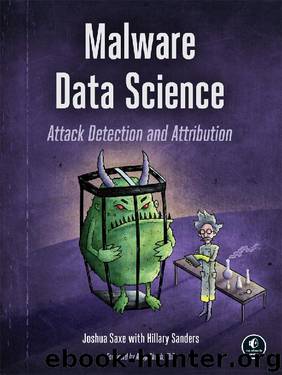Malware Data Science by Hillary Sanders & Joshua Saxe

Author:Hillary Sanders & Joshua Saxe [Hillary Sanders]
Language: eng
Format: epub, azw3
Publisher: No Starch Press
Published: 2018-09-03T21:00:00+00:00
Now suppose you want to test the detection system’s accuracy using a set of benignware and malware. You can run the detector on each binary and keep count of which of the four possible outcomes the detector gives you over the entire test set. At this point, you need some summary statistics to give you an overall sense of the system’s accuracy (that is, how likely it is that your system will generate false positives or false negatives).
One such summary statistic is the true positive rate of the detection system, which you can calculate by dividing the number of true positives on your test set by the total number of malware samples in your test set. Because this calculates the percentage of malware samples your system is able to detect, it measures your system’s ability to recognize malware when it “sees” malware.
However, simply knowing that your detection system will raise alarms when it sees malware is insufficient to evaluate its accuracy. For example, if you only used the true positive rate as an evaluation criterion, a simple function that says “yes, this is malware” on all files would yield a perfect true positive rate. The real test of a detection system is whether or not it says “yes, this is malware” when it sees malware and “no, this is not malware” when it sees benignware.
To measure a system’s ability to discern whether something is not malware, you also need to measure the system’s false positive rate, which is the rate at which your system issues a malware alarm when it sees benignware. You can calculate your system’s false positive rate by dividing the number of benign samples the system flags as malware by the total number of benign samples tested.
Download
Malware Data Science by Hillary Sanders & Joshua Saxe.azw3
This site does not store any files on its server. We only index and link to content provided by other sites. Please contact the content providers to delete copyright contents if any and email us, we'll remove relevant links or contents immediately.
| Coding Theory | Localization |
| Logic | Object-Oriented Design |
| Performance Optimization | Quality Control |
| Reengineering | Robohelp |
| Software Development | Software Reuse |
| Structured Design | Testing |
| Tools | UML |
The Mikado Method by Ola Ellnestam Daniel Brolund(20603)
Hello! Python by Anthony Briggs(19899)
Secrets of the JavaScript Ninja by John Resig Bear Bibeault(18208)
Dependency Injection in .NET by Mark Seemann(18108)
The Well-Grounded Java Developer by Benjamin J. Evans Martijn Verburg(17575)
OCA Java SE 8 Programmer I Certification Guide by Mala Gupta(17422)
Kotlin in Action by Dmitry Jemerov(17185)
Adobe Camera Raw For Digital Photographers Only by Rob Sheppard(16931)
Algorithms of the Intelligent Web by Haralambos Marmanis;Dmitry Babenko(16235)
Grails in Action by Glen Smith Peter Ledbrook(15390)
Test-Driven iOS Development with Swift 4 by Dominik Hauser(10393)
Becoming a Dynamics 365 Finance and Supply Chain Solution Architect by Brent Dawson(8056)
Microservices with Go by Alexander Shuiskov(7819)
Practical Design Patterns for Java Developers by Miroslav Wengner(7719)
Test Automation Engineering Handbook by Manikandan Sambamurthy(7672)
Angular Projects - Third Edition by Aristeidis Bampakos(7160)
The Art of Crafting User Stories by The Art of Crafting User Stories(6611)
NetSuite for Consultants - Second Edition by Peter Ries(6533)
Demystifying Cryptography with OpenSSL 3.0 by Alexei Khlebnikov(6305)
